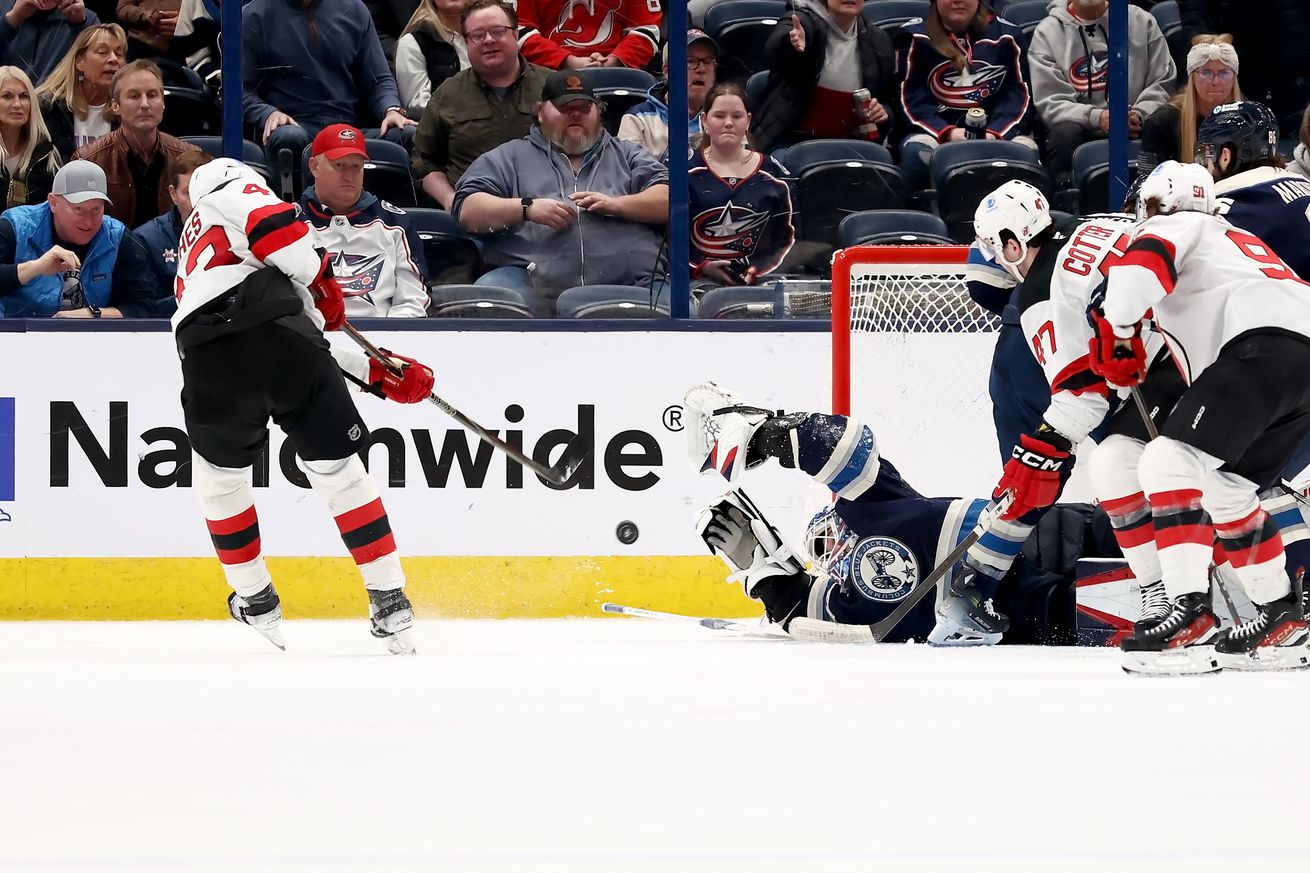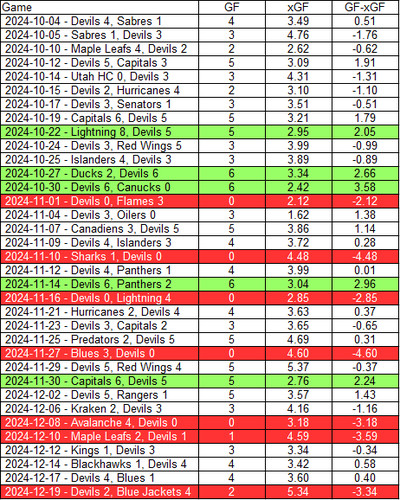
The New Jersey Devils were goalied last night in a 2-4 loss to the Columbus Blue Jackets. This post looks at how often it has happened to this season’s team and provides some hope in pointing out what has happened after each time.
On Thursday night, Elvis Merzlikins turned in one of his best performances of the season. Which, in turn, meant that the New Jersey Devils were stunned, robbed, stoned, denied, and frustrated. It seemed certain that a sixth shutout loss was on its way. A weirdly high number for a team that regularly scores over 3 goals per game. The Devils would make it a one-shot game for a few seconds. But do not let the 2-4 final score fool you. The Devils did everything to Columbus to blow them away and Elvis Merzlikins was the main man responsible for the Devils’ defeat on Thursday. The Devils were absolutely goalied. We need to discuss this topic yet again, so let us do so.
First, what does even getting goalied look like? From observation, it is seeing the opposition seemingly make all of the saves on the Devils. From routine ones to swallowing up loose pucks on jam plays and close shots to reaching out and stopping what would usually be goals on a goalie’s flank or at an open part of the net. From the flashy to the greasy, the goalie getting just about everything is what is usually looks like. Merzlikins was the latest to do it.
From data, I use a difference of goals for from the expected goals for with Natural Stat Trick’s model for all situations play. Expected goals considers other factors beyond the number of shots taken at a goalie, mostly the location as scoring chance and high-danger scoring chance attempts are more likely to become goals than other shots. It is a model so it is not perfect but it gives an objective idea of whether a team’s offense is dangerous enough to score plenty of goals. If that difference is less than or equal to -2, then the team got goalied. Alternatively, if you want to know if a team lit up a goalie, then I reverse it. A difference of GF and xGF of +2 or more means the team really gave the goalie a hard time.
What about this season? We know the Devils have been shutout five times in this season. We also know that a team can get goalied without being shutout. How many times have the Devils been goalied 35 games into their season? Seven times. All five shutouts plus the 1-2 loss to Toronto and Thursday’s 2-4 loss to Columbus. Is that a lot? I am not sure among the teams this season. For what it is worth, the Devils got goalied 10 times last season. Therefore, 7 in 35 games already seems to be quite a lot.
Who did the Devils the worst in this regard? If it was not for Luke Hughes roofing a loose puck out of a scrum in front and Timo Meier tipping in a shot by The Big Deal, then Merzlikins would have been the one to have goalied the Devils the worst. The Devils put up an xGF of 5.34, their second highest mark of the season. They scored two goals; still got goalied. The one who goalied the Devils the worst this season so far was Jordan Binnington. The Devils threw everything and a kitchen sink at the St. Louis Blues goalie on November 27. He stopped everything. The Devils lost 0-3 with a 4.60 xGF. Somehow, it was statistically worse than MacKenzie Blackwood doing it with the Sharks on November 10. You may feel that was worse since that was a 0-1 loss off a Timo Meier uninentional own goal off his leg. Either way, it was still bad.
Why does this happen? The simplest answer is that the opposition goaltender is having an awesome night. Regrettably, the opposition is allowed to be awesome.
I do not think the Devils are doing anything wrong in the games where they got goalied with the exception of their loss in Calgary. That was a classic “not much is working” game. The others saw the Devils drive their offense a whole lot. Which is a positive despite the result. How they kept attacking and kept pushing the play forward is what they should be doing in general. Frustrating as it is, but the Devils’ process in the run of play has been more than fine as they generate plenty of high danger chances and scoring chances amid other shooting opportunities. I get that it gets to a point where you just want something to change. Even where someone like Bryce Salvador praises even bumping the goaltender for interference to try to throw them off. That did not work last night, by the way. But the results will come from their efforts.
Which did happen even last night. It yielded two late goals against a seemingly invincible Merzlikins. They put themselves in a chance to get something out of the game when it seemed all but certain that they would get nothing. That is a kind of effort that can and does score a lot of goals and win a lot of games. Something the 2024-25 Devils have done on most other nights. In fact, here is a list of all of the Devils’ games this season with the difference between goals for and expected goals for. The games where the Devils get goalied are in red. The games where the Devils lit up the goalie are in green.

Natural Stat Trick
Please notice that after all but one game where the Devils got goalied, the Devils went out and scored at least three goals in their next game. They responded to a dreary performance in Calgary with a 3-0 win in Edmonton. They responded to Blackwood baffling the People Who Matter with a 4-1 statement win over the defending Stanley Cup Champions. They responded to Andrei Vasilevskiy living up to his reputation in a 0-4 loss in Tampa Bay with an excellent 4-2 home win over Carolina. They responded to Binnington’s shutout with a sloppy but successful 5-4 win on Black Friday in Detroit. A pattern is emerging here and it is a good one. The lone exception was the Avalanche 0-4 loss being followed by Anthony Stolarz playing out of his mind for Toronto – which was an OT loss. After that OT loss to Toronto, the Devils put up three on a defensively-stout Los Angeles team to win 3-1. Outside of the Toronto game, the Devils have been productive after getting goalied.
Please also notice that Jordan Binnington represents an excellent example to be confident in this year’s team. On November 27, he absolutely stonewalled the Devils. Earlier this week, just two games ago, he was beaten on a rising shortside shot from Ondrej Palat after a dump-in by Luke Hughes. The Devils put three past him in a 4-1 win. The point is that just because someone goalied the Devils once before, it does not mean they are going to do it again. This is something to keep in mind when the Devils play Colorado, Toronto, Columbus, Calgary, Tampa Bay, and San Jose again later this season.
Just as importantly, the Devils’ offensive process remains strong after getting goalied. With the exception of the Edmonton game, the Devils generated at least 3.3 xGF in each game. Which is a large amount in a league where the all situations median xGF is 2.9 in a game per Natural Stat Trick. That shows legitimate resiliency and buy-in by the players. The Devils know that how they attack the net can and does score lots of goals. Sometimes in hockey, the opposition’s goaltender is going to be awesome. There is not much of a reason to change a whole lot if or when that happens.
An adjustment may be OK. If the Devils want the “greasy” or focus on high-danger chances, then they can adjust to have Stefan Noesen, Nico Hischier, and Timo Meier shoot more. All three are in the top ten in the NHL with high-danger scoring chances taken in all situations play with 67, 65, and 57 respectively according to Natural Stat Trick. Noesen may be boosted by being a netfront player on the team’s primary power play unit, but those HDCFs still happened. By all means, if the opposition defense will just let someone The Big Deal skate through them like a knife through butter – like Columbus did last night – then do so. But if you demand HDCFs when the goalie is looking like they are on fire, then those three have been heads-and-shoulders above the Devils and the majority of the NHL in terms of making them happen. No player is above a “greasy” goal anyway.
What about demanding more from the team’s bottom six? That would be great but when a team is getting goalied, then everyone is not scoring very much. I can agree that the Devils should look to add a secondary scoring winger and a bottom-six center. It will add an extra dimension to their attack and make their team more competitive overall. But it is not necessarily going to prevent the Devils from getting goalied. As discussed in this post and in past cases where this happen, the issue is not really with the Devils. It is with the opposition goaltender and there is nothing the Devils can really do within their team to impact the opposition goaltender’s performance. As much as I want to tell you there is a way to prevent it, there really is none. The Devils have the right offensive process to generate lots of goals. Which has happened. The Devils have just 9 games out of 35 where they have been held to less than 3 goals. It just so happens they were goalied in 7 of those 9.
The good news is that the Devils have followed up getting goalied by going back to work and putting multiple goals in the net in every case except one so far this season. They have done enough to win 5 out of the 6 times they were goalied prior to Thursday’s game. We shall see if they make it 6 out of 7 against Pittsburgh on Saturday. I like the Devils’ chances. Your feelings may vary. Please leave your thoughts about the Devils getting goalied so far this season, as well as how the Devils have responded and attacked in general in the comments. Thank you for reading.
